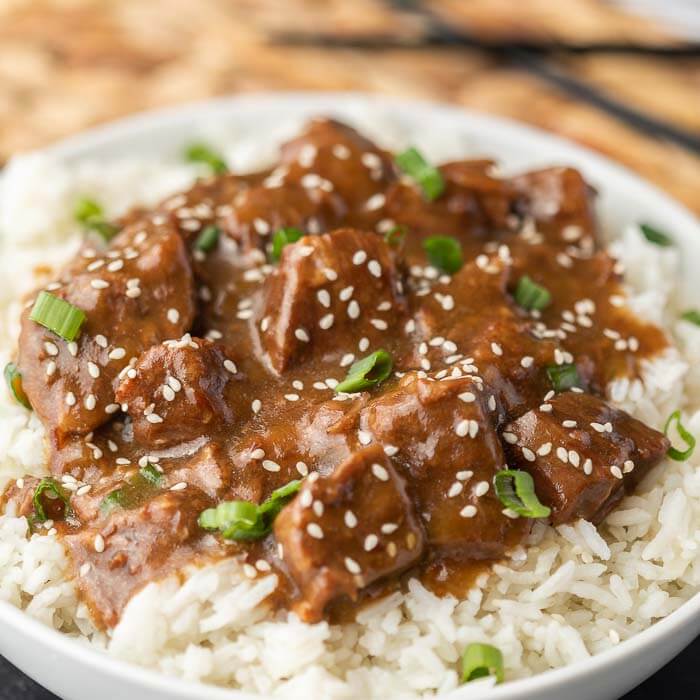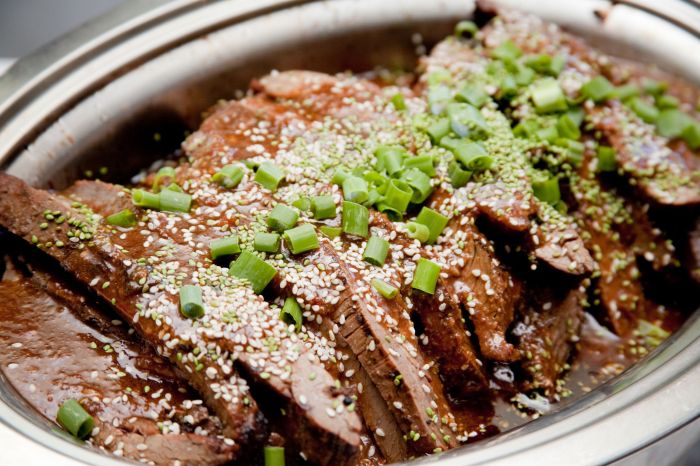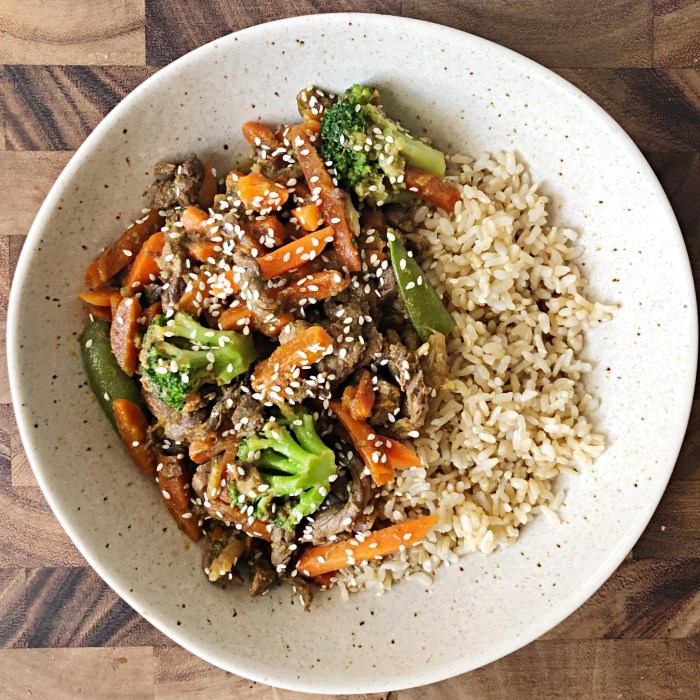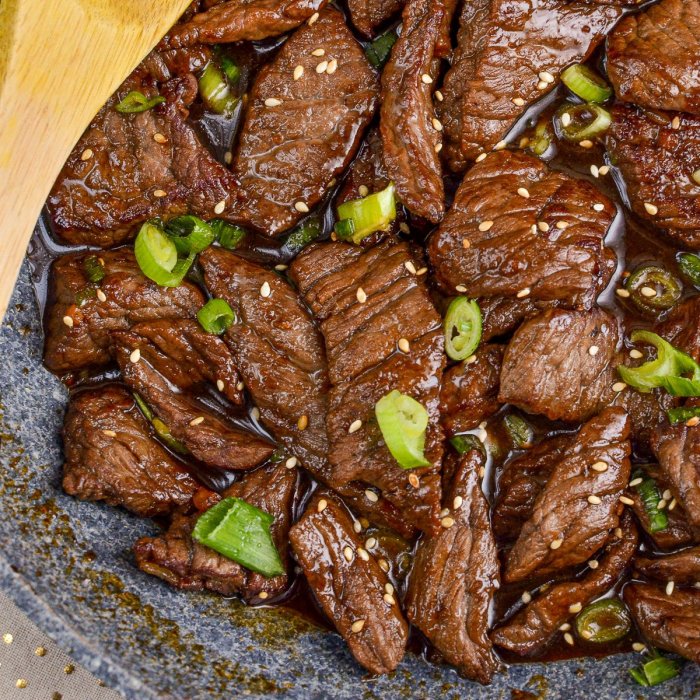Beef teriyaki recipe is a culinary delight that brings together the savory flavors of beef with the sweet and tangy notes of teriyaki sauce. Originating in Japan, teriyaki has become a beloved dish worldwide, and its versatility allows for countless variations and adaptations.
The key to a successful beef teriyaki recipe lies in achieving a balance of sweet, savory, and salty flavors. The teriyaki sauce, typically made with soy sauce, sugar, mirin, and sake, is the star of the show, adding a rich and complex depth to the dish.
The beef, whether it be tenderloin, sirloin, or flank steak, is marinated in the sauce, allowing the flavors to permeate and create a symphony of taste.
Introduction to Beef Teriyaki

Beef teriyaki is a popular dish that combines the savory flavors of grilled beef with the sweet and tangy notes of teriyaki sauce. This dish has its roots in Japanese cuisine and has become a global favorite, enjoyed for its versatility and delicious taste.
Origins and History of Teriyaki
Teriyaki, meaning “grilled with soy sauce,” originated in Japan centuries ago. Initially, the technique involved marinating fish in a mixture of soy sauce, sake, and mirin, then grilling it over charcoal. This method preserved the fish while imparting a rich, umami flavor.
Over time, teriyaki evolved to include other ingredients and cooking methods, becoming a versatile technique for preparing various meats, vegetables, and seafood.
Key Ingredients and Flavors of Teriyaki Sauce
Teriyaki sauce is the heart of the dish, creating a balance of sweet, savory, and slightly salty flavors. The essential ingredients include:
- Soy sauce: Provides a salty and umami base.
- Mirin: A sweet rice wine that adds depth and complexity.
- Sake: A fermented rice wine that contributes to the overall flavor profile.
- Sugar: Balances the savory flavors and adds sweetness.
- Ginger: Adds a subtle warmth and spice.
- Garlic: Enhances the savory notes and provides a pungent aroma.
These ingredients are often combined in varying proportions, resulting in unique flavor profiles. Some recipes also include ingredients like cornstarch for thickening, sesame oil for a nutty aroma, or chili peppers for a spicy kick.
Types of Beef Used in Teriyaki Recipes
The type of beef used in teriyaki can significantly impact the dish’s texture and flavor. Here are some common options:
- Sirloin: A lean cut with a good amount of marbling, providing a tender and flavorful result.
- Flank steak: A flavorful cut with a tougher texture, best suited for thin slices that are marinated and cooked quickly.
- Rib-eye: A richly marbled cut, offering a tender and juicy experience with a pronounced beefy flavor.
- Tenderloin: A very tender and lean cut, often used for steak, but can also be sliced and used in teriyaki.
The choice of beef ultimately depends on personal preference and the desired outcome.
Essential Ingredients for Beef Teriyaki: Beef Teriyaki Recipe

A delicious beef teriyaki dish relies on a well-balanced blend of ingredients. The key is to find the right combination of savory, sweet, and umami flavors to create a truly satisfying experience. Let’s delve into the essential ingredients and their roles in creating this culinary masterpiece.
Beef
The star of the show is the beef. You can choose from various cuts, each offering a unique texture and flavor.
- Sirloin:This cut is lean and tender, making it ideal for grilling or pan-frying.
- Flank Steak:A flavorful and tougher cut, flank steak benefits from marinating and slicing against the grain.
- Ribeye:This marbled cut provides rich flavor and tenderness, perfect for a more luxurious experience.
Teriyaki Sauce
The soul of the dish lies in the teriyaki sauce. Its sweet and savory notes complement the beef perfectly.
- Soy Sauce:Provides saltiness and umami depth.
- Mirin:A sweet rice wine, adds a delicate sweetness and enhances the overall flavor profile.
- Sugar:Balances the saltiness of the soy sauce and adds a touch of sweetness.
- Sake:A Japanese rice wine, contributes to the depth of flavor and adds a subtle complexity.
- Ginger:Offers a warm and slightly spicy flavor.
- Garlic:Adds a pungent and aromatic element to the sauce.
Other Ingredients
Beyond the beef and teriyaki sauce, other ingredients enhance the dish’s overall flavor and texture.
- Sesame Seeds:Provide a nutty and crunchy texture.
- Green Onions:Add a fresh and slightly pungent flavor.
- Sesame Oil:Offers a nutty and aromatic flavor, perfect for stir-frying or pan-frying.
Preparing the Beef
The heart of any teriyaki dish is the beef, and getting it right is crucial. Proper preparation involves selecting the right cut, marinating it for optimal flavor, and searing it to perfection.
Marinating Techniques
Marinating beef is an essential step in teriyaki preparation. It infuses the meat with flavor, tenderizes it, and helps create a delicious, glazed finish. Two common techniques are wet marinades and dry marinades.
- Wet Marinades: These are the most popular type of marinade, consisting of a liquid base, typically soy sauce, mirin, sake, and sugar. Wet marinades penetrate the beef quickly, creating a deep, flavorful coating.
- Dry Marinades: Dry marinades are typically made from a mixture of spices, herbs, and sometimes salt and sugar. They are applied directly to the surface of the beef, relying on the friction of the spices to create flavor. Dry marinades are excellent for adding depth and complexity to the beef’s flavor profile.
Cutting and Searing
Once the beef is marinated, it’s time to cut and sear it.
- Cutting: The best cuts of beef for teriyaki are those that are tender and marinate well. Popular choices include flank steak, sirloin, and ribeye. These cuts should be sliced against the grain for optimal tenderness.
- Searing: Searing the beef is crucial for developing a flavorful crust. A hot pan or grill is essential for this step. Searing creates a beautiful caramelization on the surface of the beef, enhancing the flavor and texture.
Achieving Desired Doneness
The level of doneness you prefer for your beef will depend on your personal taste.
- Rare: Rare beef has a bright red center and is typically cooked to an internal temperature of 125°F (52°C).
- Medium-Rare: Medium-rare beef has a pink center and is cooked to an internal temperature of 130°F (54°C).
- Medium: Medium beef has a light pink center and is cooked to an internal temperature of 140°F (60°C).
- Medium-Well: Medium-well beef has a slight pink tinge in the center and is cooked to an internal temperature of 150°F (66°C).
- Well-Done: Well-done beef has a brown center and is cooked to an internal temperature of 160°F (71°C).
Making the Teriyaki Sauce
The teriyaki sauce is the heart and soul of this dish, lending its signature sweet and savory flavor to the beef. It’s a simple sauce to make, but getting the balance of flavors just right is key. Here’s how to make a traditional teriyaki sauce from scratch:
Traditional Teriyaki Sauce Recipe
To make a traditional teriyaki sauce, you’ll need a few basic ingredients: soy sauce, mirin (sweet rice wine), sake (Japanese rice wine), sugar, and cornstarch. The exact proportions of these ingredients can vary depending on personal preference, but a good starting point is:
- 1/2 cup soy sauce
- 1/4 cup mirin
- 1/4 cup sake
- 1/4 cup sugar
- 1 tablespoon cornstarch
To make the sauce, simply whisk together all the ingredients in a saucepan over medium heat. Bring the mixture to a simmer, stirring constantly, until the sugar dissolves and the sauce thickens. The cornstarch helps to create a glossy and slightly syrupy texture.
A well-balanced teriyaki sauce should be sweet, savory, and slightly salty.
Balancing Flavors
Achieving the perfect balance of flavors in your teriyaki sauce is key. Here are some tips to help you get it right:
- Start with a small amount of sugar and add more to taste. You can always add more sugar, but it’s harder to remove it once it’s in the sauce.
- Use high-quality soy sauce for a richer and more complex flavor.
- If the sauce is too sweet, add a little more soy sauce to balance it out.
- If the sauce is too salty, add a little more sugar or mirin.
Variations and Alternatives
There are many variations and alternative teriyaki sauce recipes that you can explore. For example, some people like to add ginger, garlic, or sesame oil to their teriyaki sauce. Others prefer to use honey instead of sugar. You can also find ready-made teriyaki sauce at most grocery stores, but making your own sauce from scratch allows you to control the ingredients and create a flavor that you truly enjoy.
Cooking the Beef Teriyaki
Now that you have prepared the beef and teriyaki sauce, it’s time to cook the dish! You can cook the beef teriyaki using different methods, each offering a unique flavor and texture.
For descriptions on additional topics like dragonheir cooking recipes book s2, please visit the available dragonheir cooking recipes book s2.
Grilling
Grilling is an excellent option for achieving a crispy exterior and juicy interior. To grill beef teriyaki, preheat your grill to medium-high heat. Lightly oil the grill grates to prevent sticking. Place the beef on the grill and cook for 2-3 minutes per side, or until cooked to your desired doneness.
Brush the beef with the teriyaki sauce during the last minute of grilling to caramelize the sauce.
Pan-Frying, Beef teriyaki recipe
Pan-frying is a quick and easy way to cook beef teriyaki. Heat a tablespoon of oil in a large skillet over medium-high heat. Add the beef to the skillet and cook for 2-3 minutes per side, or until cooked to your desired doneness.
Pour the teriyaki sauce over the beef and bring to a simmer. Cook for another 2-3 minutes, or until the sauce has thickened and the beef is coated.
Baking
Baking is a great option for a hands-off approach. Preheat your oven to 350°F (175°C). Place the beef in a baking dish and pour the teriyaki sauce over it. Cover the dish with aluminum foil and bake for 20-25 minutes, or until the beef is cooked to your desired doneness.
Uncover the dish and bake for another 5-10 minutes to allow the sauce to caramelize.
Serving and Presentation
Beef teriyaki is a versatile dish that can be served in various ways, depending on your preference and the occasion. Whether you’re enjoying it for a casual weeknight dinner or a more formal gathering, there are traditional methods and creative ideas to elevate your presentation.
Traditional Serving Methods
Traditional methods often involve serving beef teriyaki with rice as a base. This combination provides a balance of savory and sweet flavors, with the rice absorbing the delicious teriyaki sauce. The dish is typically served in a bowl or on a plate, with the beef arranged on top of the rice.
Side Dishes and Garnishes
Side dishes and garnishes can further enhance the flavor and presentation of beef teriyaki.
- Vegetables: Stir-fried vegetables, such as broccoli, carrots, and snap peas, provide a vibrant contrast in color and texture.
- Salads: A simple green salad with a light vinaigrette adds a refreshing element.
- Pickled Ginger: Pickled ginger, often served alongside sushi, can help cleanse the palate between bites and enhance the overall dining experience.
- Sesame Seeds: Toasted sesame seeds sprinkled on top add a nutty aroma and a subtle crunch.
Aesthetic Presentation
Creating an aesthetically pleasing presentation can elevate your beef teriyaki from a simple meal to a culinary masterpiece.
- Garnish with fresh herbs: Sprigs of cilantro, parsley, or green onions add a touch of freshness and vibrancy.
- Arrange the beef artfully: Consider fanning the beef slices or creating a visually appealing pattern on the plate.
- Use contrasting colors: Incorporate vibrant side dishes or garnishes to create a visually appealing contrast.
- Serve on a visually appealing plate: A simple white plate allows the colors of the dish to stand out, while a patterned plate can add a touch of elegance.
Variations and Adaptations

Beef teriyaki is a versatile dish that can be adapted to suit various tastes and dietary needs. Experimenting with different ingredients and techniques can lead to exciting variations and personalized creations.
Adapting the Recipe for Dietary Restrictions
The basic beef teriyaki recipe can be easily modified to accommodate common dietary restrictions. For example, using gluten-free soy sauce or tamari will make the dish suitable for those following a gluten-free diet.
- Gluten-Free: Replace regular soy sauce with gluten-free soy sauce or tamari.
- Vegetarian: Substitute the beef with firm tofu, seitan, or portobello mushrooms.
- Vegan: Use vegan-friendly soy sauce or tamari, and replace the honey with agave nectar or maple syrup.
Tips for Success

Making a delicious beef teriyaki is all about getting the balance right. From the beef to the sauce, there are a few key things to keep in mind to ensure a successful outcome.
- Use high-quality beef: The quality of the beef will directly impact the flavor and texture of your teriyaki. Opt for a cut that’s marbled for a tender and flavorful result. Sirloin, ribeye, or tenderloin are excellent choices.
- Don’t overcook the beef: Beef teriyaki is best when cooked medium-rare to medium. Overcooked beef will be tough and dry.
- Let the sauce simmer: Allow the teriyaki sauce to simmer for a few minutes to thicken and develop its rich flavor.
- Don’t overcrowd the pan: When cooking the beef, make sure you don’t overcrowd the pan. This will prevent the beef from browning properly and the sauce from reducing effectively.
- Use a thermometer: A meat thermometer is essential for ensuring the beef is cooked to your desired doneness.
Troubleshooting Common Issues
Sometimes, things don’t go exactly as planned in the kitchen. Here are some tips for dealing with common issues that may arise when making beef teriyaki:
- Beef is too tough: If the beef is too tough, it’s likely that it was overcooked. To prevent this, use a meat thermometer and cook the beef to the desired doneness.
- Sauce is too thin: If the sauce is too thin, it’s likely that it didn’t simmer long enough. Allow the sauce to simmer for a few more minutes until it thickens to your liking.
- Sauce is too sweet: If the sauce is too sweet, you can add a little bit of soy sauce or rice vinegar to balance the sweetness.
- Beef is too salty: If the beef is too salty, you can rinse it under cold water before cooking. You can also reduce the amount of soy sauce in the teriyaki sauce.
Storing and Reheating Leftovers
Leftover beef teriyaki can be stored in an airtight container in the refrigerator for up to 3 days. To reheat, you can microwave it or pan-fry it.
When reheating, be sure to watch it closely to prevent it from drying out. You can add a little bit of water or teriyaki sauce to keep it moist.
Closure
From the marinade to the cooking process, each step plays a crucial role in crafting a memorable beef teriyaki experience. The right balance of ingredients, cooking techniques, and presentation come together to create a dish that is both delicious and visually appealing.
Whether you’re a seasoned chef or a culinary novice, this recipe offers a journey of flavors and textures that will tantalize your taste buds and leave you wanting more.
